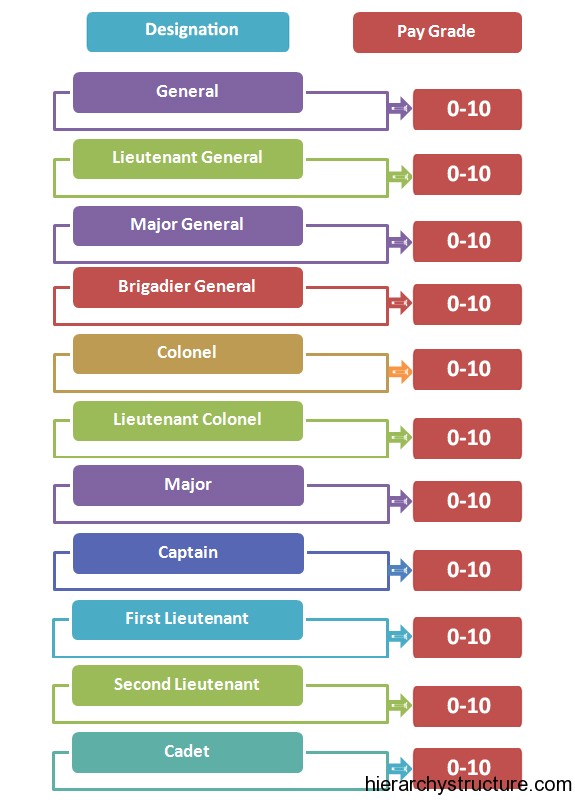Military hierarchy is a fundamental aspect of armed forces worldwide, serving as the backbone of organization, command, and control. Understanding the military hierarchy is essential not only for those serving in the military but also for civilians who seek to comprehend how military operations are conducted. This article dives deep into the intricacies of military hierarchy, exploring its structure, roles, and significance in maintaining order and efficiency within military organizations.
The military hierarchy is a system that ranks individuals within the armed forces, establishing clear lines of authority and responsibility. Each level of the hierarchy is integral to the functioning of the military, ensuring that orders are effectively communicated and executed. By examining the various ranks and the roles associated with them, we can appreciate how this structure contributes to the overall mission of military forces.
In this article, we will explore the different branches of the military, the rank structure within each branch, and the significance of military hierarchy in strategic planning and operations. We will also look at historical examples and current applications of military hierarchy to provide a comprehensive understanding of this vital topic.
Table of Contents
- 1. Overview of Military Branches
- 2. Understanding Rank Structure
- 3. Key Roles Within the Military Hierarchy
- 4. Importance of Military Hierarchy
- 5. Historical Examples of Military Hierarchy
- 6. Current Applications in Modern Military
- 7. Challenges and Evolutions in Military Hierarchy
- 8. Conclusion
1. Overview of Military Branches
The military is typically divided into several branches, each with distinct roles and responsibilities. The main branches include:
- Army: The land-based military force responsible for ground warfare.
- Navy: The maritime military force tasked with naval operations.
- Air Force: The aerial military force dedicated to air combat and support.
- Marine Corps: A rapid-response force specializing in amphibious operations.
- Coast Guard: A maritime security organization focused on law enforcement and search and rescue.
Each branch operates under its own hierarchy, with a unique set of ranks and responsibilities tailored to its specific mission.
2. Understanding Rank Structure
Military rank structure is essential to establishing authority and operational effectiveness. Ranks are typically organized in a hierarchical manner, with higher ranks holding more authority and responsibility.
2.1 Enlisted Ranks
Enlisted personnel form the backbone of the military. They are responsible for executing orders and performing specific tasks. Common enlisted ranks include:
- Private
- Corporal
- Sergeant
2.2 Officer Ranks
Officers hold leadership positions and are responsible for planning, directing, and managing military operations. Common officer ranks include:
- Lieutenant
- Captain
- Colonel
- General
3. Key Roles Within the Military Hierarchy
Each rank within the military hierarchy plays a critical role in the functioning of the armed forces. Understanding these roles is essential for grasping how military operations are conducted.
3.1 Leadership Roles
Leaders at various levels are responsible for making strategic decisions, guiding their teams, and ensuring mission success. Key leadership roles include:
- Platoon Leader
- Company Commander
- Brigade Commander
3.2 Support Roles
Support personnel provide essential services that enable combat operations. These roles include:
- Logistics Specialist
- Medical Personnel
- Intelligence Analysts
4. Importance of Military Hierarchy
The military hierarchy is crucial for several reasons:
- Clear Command Structure: Ensures orders are communicated effectively.
- Accountability: Establishes responsibility at all levels of operation.
- Efficiency: Facilitates rapid decision-making in high-pressure situations.
5. Historical Examples of Military Hierarchy
Throughout history, military hierarchies have played a vital role in the success of military campaigns. Notable examples include:
- The Roman Army: Known for its strict hierarchy and organization.
- World War II: The Allied forces utilized hierarchical command structures to coordinate complex operations.
6. Current Applications in Modern Military
Today, military hierarchies continue to evolve, adapting to new technologies and strategies. Current applications include:
- Integrated Command Structures: Combining joint forces for more effective operations.
- Utilization of Technology: Leveraging communication tools to enhance command and control.
7. Challenges and Evolutions in Military Hierarchy
As military operations become more complex, challenges arise in maintaining effective hierarchies. Some challenges include:
- Adapting to Technological Changes
- Ensuring Inclusivity and Diversity
- Balancing Tradition with Innovation
8. Conclusion
In conclusion, understanding military hierarchy is crucial for recognizing how armed forces operate effectively. The structured command system ensures that orders are executed efficiently, which is vital in times of crisis. We encourage readers to explore more about military hierarchy, share their thoughts in the comments, and check out other articles on our site for further insights.
Thank you for engaging with our article. We hope you found the information valuable and invite you to return for more in-depth discussions on military topics and beyond.
Rylee Arnold Age: Everything You Need To Know About The Rising Star Of DWTS
Discovering The Life Of Taylor Swift: A Journey Through Music And Fame
Exploring Adam Sandler's Romantic Life: His Girlfriend And Relationships


